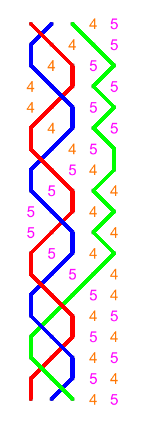Teaching ringers to cover
Covering develops a ringer’s ropesight, the ability to see bells changing below them, and gives them a feeling of the rhythm of the change.
To cover confidently and well your ringer needs to develop four skills:
Listening – the ability to hear their bell amongst others
A sense of rhythm – getting the feeling
Awareness of their place in the row – place counting
Ropesight – the ability to identify which bells to follow
Preparation
Your ringer is ready to learn to cover when they can:
- Ring rounds
- Hear what place their bell is sounding in
- Recognise when their bell is out of place in rounds
- Adjust their bell to get it back into rounds
- Ring the tenor
Ringing the tenor in rounds will help the ringer get their ear tuned in to listening to themselves in 6th place. Always make sure the ringer is counting their place in rounds.
Using a simulator to allow a ringer to ring rounds in 6th place is a
useful exercise. The latest software with moving ringers which can be shown
on a screen or large TV are particularly useful at this stage.
There is little theory required when teaching covering. However, remember to point out that when covering to Plain Hunt or methods, the bells change below on a backstroke for odd bell numbers and handstroke for even bell numbers.
Putting it into action
Teach your ringers to cover in graded steps making each step easier to achieve:
- Call Changes
- Place making, dodging, Kaleidoscope sequences
- Plain Hunt on 3, 4 and then bells
- On 8 bells steady ringing with 768 behind to develop 8 bell rhythm
- Methods - plain courses, touches and then different methods
Introductory Exercises
The first opportunity for the ringer to do this is when ringing call changes; the ringer need not be ringing the tenor at this time.Kaleidoscope ringing also provides an opportunity for a ringer to cover to two bells making long places, places or dodging. To find out more about Kaleidoscope Ringing see Level 2 – Teaching foundation skills. Ringing the tenor in rounds will help the ringer get his or her ear tuned in to listening to themselves in 6th place. Always make sure the ringer is counting their place in rounds.

Once the ringer can cover to rounds and Call Changes and Kaleidoscope Ringing they can move on to covering to Plain Hunt. Let them stand behind the tenor ringer to learn to follow the ropesight. If the ringer finds difficulty in covering to Plain Hunt on 5 then it is possible to start with covering to hunting on 3 or 4 bells.
Once the ringer is striking well to covering to Plain Hunt on five they are ready to move on to cover to methods. Start with plain courses moving on to touches when the striking is accurate. Plain Bob has a coursing order most similar to Plain Hunt and may be a good method to start with. However other methods where a smaller number of bells come to the back may also be useful.
Cloisters Doubles or Stedman quick sixes is a method where only three bells [the 3, 4 and 5] come to the back providing easier ropesight for the learner - see diagram to the right.
Can ropesight be taught?
Ropesight is a visual skill. It is a skill learned through experience and cannot be learned from a book. The eyes gradually learn to pick up moving ropes in the periphery of their visual field. For this skill to develop, practice is needed and this takes time. Ringers will need varying amounts of practice to develop ropesightl; some will find it easier than others! It is our job as teachers to provide the amount of practice in the appropriate environment with sufficient support to ensure our ringers gain the skills required.
Teaching Tips
- Get the ringer to stand behind the tenor ringer to watch and learn
- During early attempts stand with the ringer to assist with the ropesight if the striking strays. A visual prompt, pointing or gesturing in the right general direction of the bell which should be followed can assist
- By grading your teaching starting with something the ringer can do easily will enable them to achieve success. Some ringers will not need all the smaller steps or can move through them very swiftly
- Remember all ringers will be different and you need to keep your teaching flexible
- Making sure your ringer experiences success which will boost their confidence
- Some ringers learn to cover by ringing with the rhythm and developing the ropesight over time and some pick up the ropesight earlier but need time to develop the feeling of the rhythm
Ringing a quarter peal on the tenor
You should ensure that your ringer is not merely memorising the pattern of bells coming to the back before they ring their first quarter peal. To be certain that they have developed the skill of covering make sure they can cover to touches of at least two different Doubles methods.
Once your ringer has developed the ropesight for covering and following different bells while staying in the same place themselves they will be ready to move on to developing their ropesight whilst their bell is changing place. They will be ready to move on to learn to Plain Hunt.

Direct your ringers to this SmART Ringer page where they can learn more of the theory and practice of covering.
Pip Penney